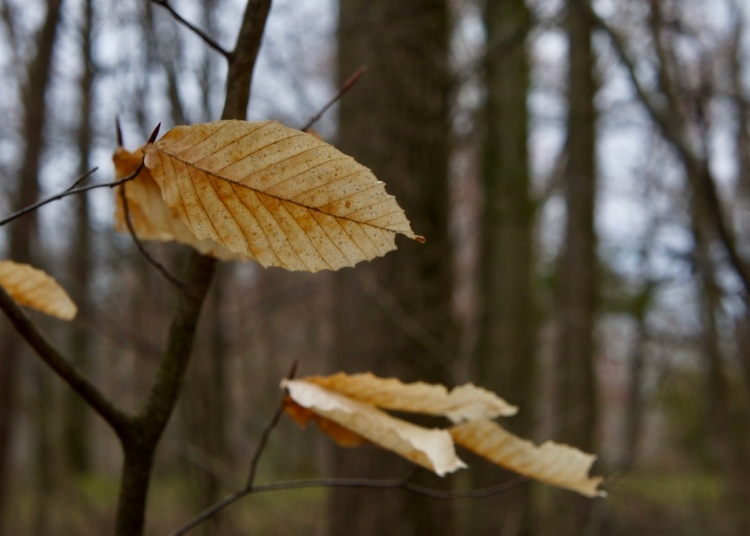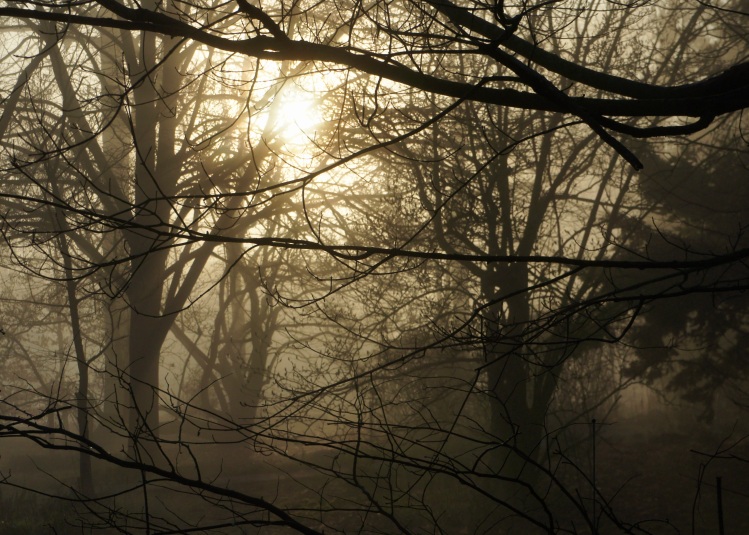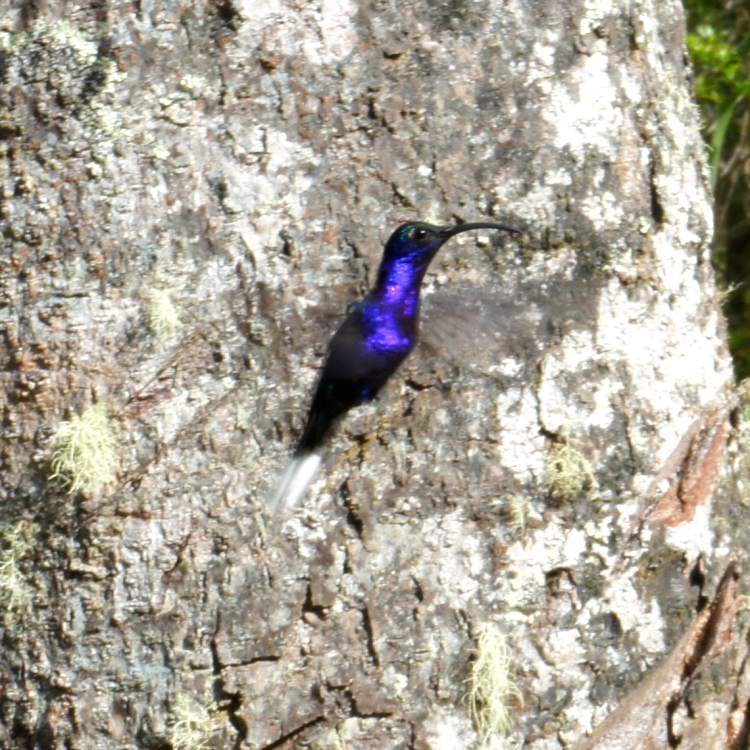
Our dogs, a path through a forest of ghostly American Beech, a fifty foot cliff of ferns, roots, and sycamore, spring just beginning to flourish, the ruins of a sand quarry that may have given us the green Coke bottle, three of my four grown children, a gray day in the midst of a global pandemic, and this thing shining off the edge of the trail with a leopard slug tucked in its folds: witches’ butter.
I suppose this is a reason to go outside. Sometimes you know what you’ll find. Most of the list above I could have predicted before we set off for Fern Cliff, the precious little nature preserve a few miles from our home in Putnam County, Indiana. And that’s OK, but sometimes you find something you’ve never seen that you cannot name. And, when you find out its name, you love the person who, centuries before you saw this strange yellow tree fungus called it witches’ butter or the others who gave it its scientific name Tremella mesenterica (trembling middle intestine) or said yellow brain, golden jelly fungus, yellow tremble. I most like the name witches’ butter as it conjures a kind of churning madness and magic. And given the fact that we saw a leopard slug on top of it after my daughter Ruth had spotted it – well, what a photo opportunity. Slime on slime and, I’m no expert, but I believe the little black flowers are slug droppings. Still, how can you not call this little piece of sunshine beautiful? 
Here’s a forest in action. I’ve done a little looking around the web – Wikipedia, Michigan State’s extension program’s writer Mike Shira explaining how fungi work, the OED – and learned that witches’ butter loves dead branches or recently fallen branches and, as many mushrooms and fungi do, Tremella mesenterica breaks down the lignin, the tough cell walls that make wood hard. Witches’ butter and its companion fungi break down the fallen limbs to create nutrients for all the green we’ll soon start seeing on the forest floor – mayapple spreading, tiny saplings poking through decaying leaves. And, of course the snail without its shell, the slimy leopard slug, is eating and breaking down the fungus. To put it crassly – slime and shit are good for the forest. And, in turn, the forest is good for us.
Beyond our special find, we walked our dogs through a huge stand of my favorite trees in late fall, winter, and early spring: the American beech. Here in the Midwest these gorgeous translucent leaved ghosts hold their foliage the whole winter. So while you walk through a bare forest, the young American beech trees flutter like living clouds.


And at the cliffs—formed sandstone from the dead sediment of snails, scallops, crinoids, and brachiopods that lived in shallow seas over 300 million years ago—ferns, those equally ancient plants that flourish even in winter. I’ve seen their deep green colors coming out of snow.



When people characterize Indiana as one big flat cornfield, I want to grab them and take them here to listen to the Snake creek snaking along the bottom on its way to the Wabash and the Ohio and the Mississippi and the Gulf of Mexico. I want to let them climb down through the gaps of giant boulders to think about the last ice age and how these creeks were formed from the glacial melt of ten millennia ago.

And if they’ve had enough of my natural history lesson, I can take them down to the ruins of the Root Glass Company’s sand quarry that, legend has it, gave its sand to make the first Coca Cola bottles. A special sand with minerals that turned the bottle “Georgia green.” (Click here to find out more from Mark Bennett at Terre Haute’s Tribune Star ).

 From article linked above. Root Glass Company Fern Cliff Sand Quarry. c. 1915
From article linked above. Root Glass Company Fern Cliff Sand Quarry. c. 1915
So witches’ butter, history, natural history, science, botany, names, beauty, and a place to walk your dogs. Stay home, but if you can sneak away and keep your distance from others, go outside and open your minds and eyes and ears. You don’t have to go far. Who knows what nature’s witches might make for you?
Be Well.
© Joseph Heithaus. All Rights Reserved.

 When my wife looks at an infant, you can feel the warmth. As her face brightens and her mouth forms coos, you can practically hear the hiss of logs smoldering in a hearth, smell wood smoke. The two of us have this in common; we become more receptive, more protective when we are around babies. I think this is mostly true of humans. We generally feel something inside ourselves switch on when we look into the eyes of an infant. The same goes for when we look at animals, and especially the ones that resemble us.
When my wife looks at an infant, you can feel the warmth. As her face brightens and her mouth forms coos, you can practically hear the hiss of logs smoldering in a hearth, smell wood smoke. The two of us have this in common; we become more receptive, more protective when we are around babies. I think this is mostly true of humans. We generally feel something inside ourselves switch on when we look into the eyes of an infant. The same goes for when we look at animals, and especially the ones that resemble us.



 The beach was ours and the sea. And the sky, of course was ours as well, freighting magnificent frigate birds, swinging pelicans from the finest filaments of wind. As we churned across the water toward the sand, the waves scatter of salt and breeze poured across the boats’ bows. We took in volcanoes in the near distance with their weather of clouds, and the dry forests along the shore with their mangroves, acacias, gumbo limbos and hundreds of other species.
The beach was ours and the sea. And the sky, of course was ours as well, freighting magnificent frigate birds, swinging pelicans from the finest filaments of wind. As we churned across the water toward the sand, the waves scatter of salt and breeze poured across the boats’ bows. We took in volcanoes in the near distance with their weather of clouds, and the dry forests along the shore with their mangroves, acacias, gumbo limbos and hundreds of other species. So yesterday I tried to take myself back to Costa Rica or maybe I had lugged the quiet of the Friends Meeting in Monteverde back to my community. I had organized, with little fanfare, something I called “Quiet at 4.” A half hour of quiet from about 4 until 4:30 on a Thursday.
So yesterday I tried to take myself back to Costa Rica or maybe I had lugged the quiet of the Friends Meeting in Monteverde back to my community. I had organized, with little fanfare, something I called “Quiet at 4.” A half hour of quiet from about 4 until 4:30 on a Thursday.





 You go away and then come back. The idea is to return changed so you might re-see, re-envision, revise whatever you were up to before you left. This is a principle of writing. The slow process of drafting, walking away, and returning again to see anew what you had written to make it better. Even this paragraph has experienced this process in the last few days.
You go away and then come back. The idea is to return changed so you might re-see, re-envision, revise whatever you were up to before you left. This is a principle of writing. The slow process of drafting, walking away, and returning again to see anew what you had written to make it better. Even this paragraph has experienced this process in the last few days.




